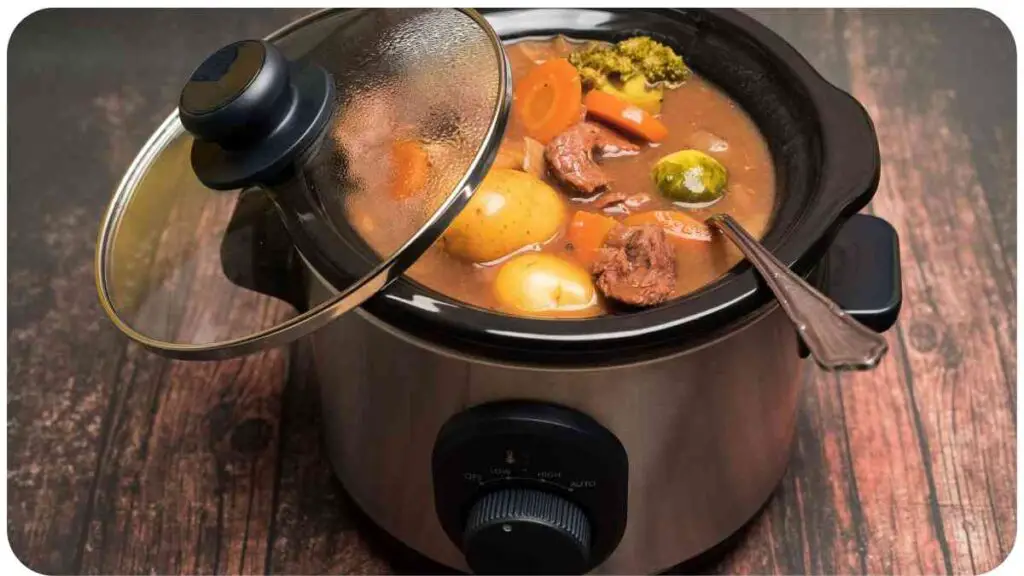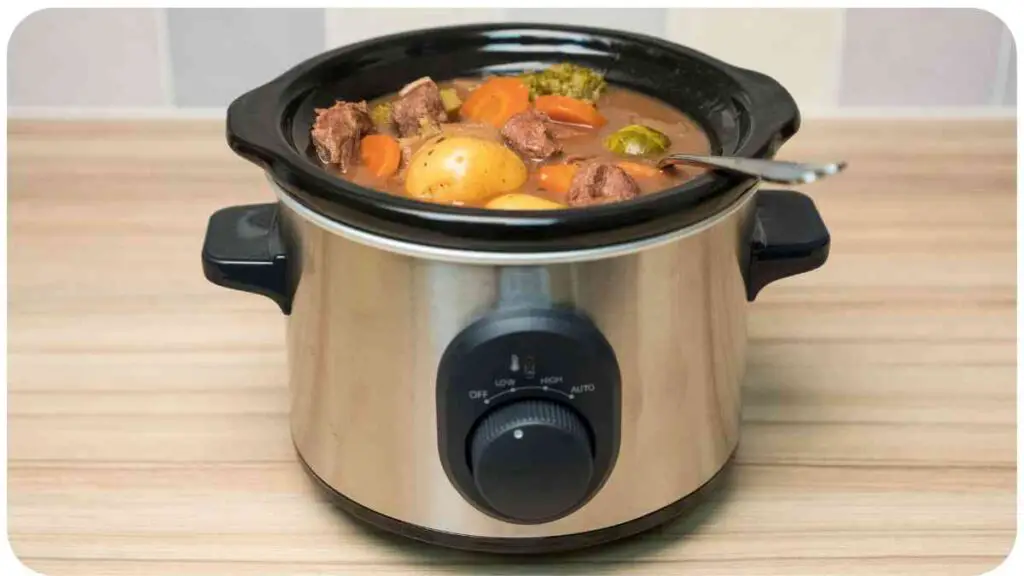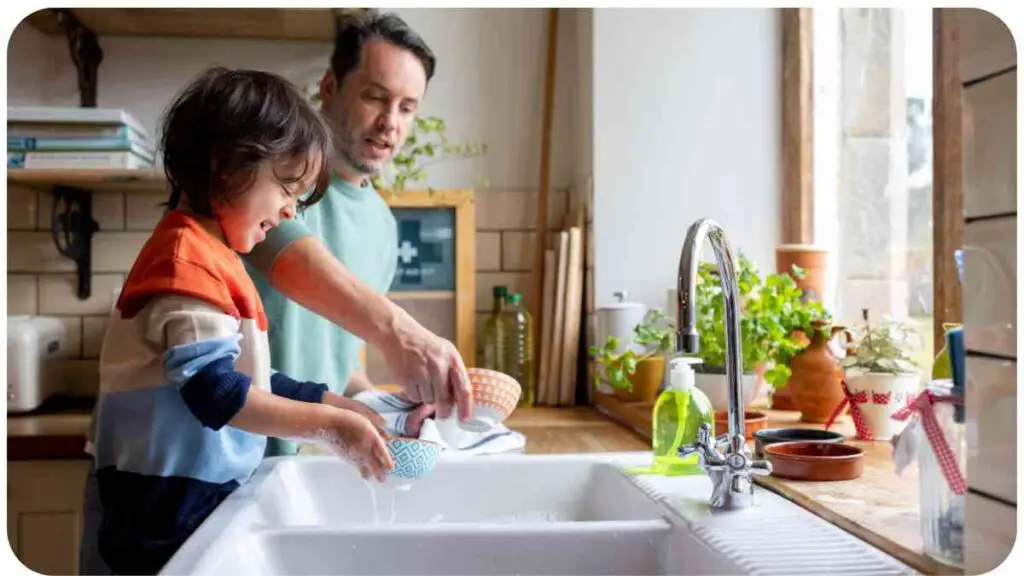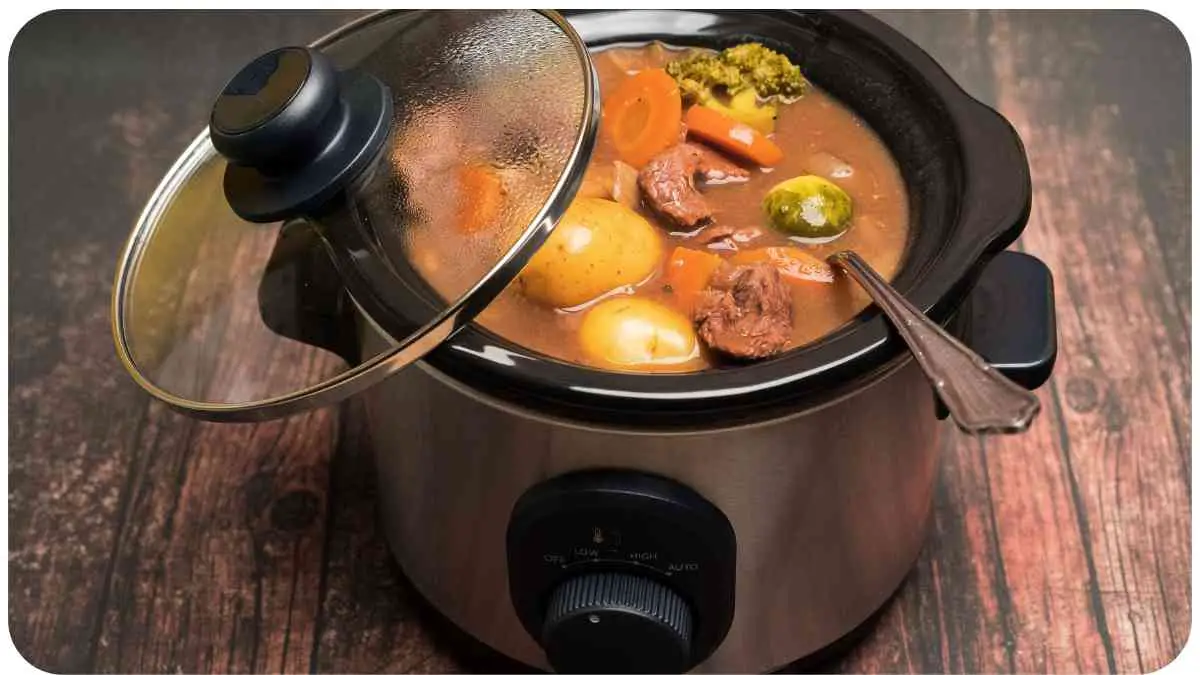Slow cookers are a kitchen staple, offering convenience and delicious meals with minimal effort. However, sometimes you may encounter issues that hinder your slow cooking experience. In this article, we will address common slow cooker troubles and provide you with practical solutions to overcome them.
Whether you’re dealing with a slow cooker that isn’t heating properly, undercooking or overcooking dishes, or facing other problems, we’ve got you covered with troubleshooting steps and expert advice.
| Key Takeaways |
|---|
| Fixing common problems with slow cookers is possible with the right knowledge and troubleshooting methods. |
| Resources such as Slow Cooker Society, Fixit Club, and Kitchen Flock offer valuable information and tips on addressing slow cooker issues. |
| Heating problems, lid issues, timer malfunctions, power cord troubles, and pot cracking are among the common problems that can be resolved. |
| Regular maintenance, proper ingredient preparation, and correct usage of the slow cooker lid contribute to optimum cooking results. |
| Adjusting cooking time and temperature, selecting appropriate recipes, and choosing the right size slow cooker are important factors to consider. |
2. Common Slow Cooker Problems and Solutions
2.1 Slow Cooker Not Heating
If your slow cooker isn’t heating up, it can be frustrating. The most common cause of this issue is a faulty power connection. To address this problem, start by checking the power cord and outlet for any visible damage. Ensure that the cord is securely plugged in and consider using a different outlet. If the cooker still fails to heat, it might be a defective heating element. In such cases, contacting the manufacturer or seeking professional help is advisable.
Upgrade your cooking game with these top kitchen tools for a more efficient and enjoyable culinary experience. From versatile blenders to high-quality knives, these essential tools will transform your cooking skills. Discover new recipes and techniques with the help of these top kitchen tools, making your time in the kitchen a breeze.
| Potential Causes | Solutions |
| Faulty power connection | Check power cord and outlet for damage. Ensure proper connection. |
| Defective heating element | Contact the manufacturer or seek professional assistance. |
2.2 Slow Cooker Overcooking

Having your meals turn into mush due to overcooking can be disheartening. To prevent overcooked dishes, ensure you’re not leaving the food in the slow cooker for longer than necessary. If your slow cooker lacks programmable settings, consider using a timer to avoid overcooking. Additionally, be cautious with the amount of liquid you use, as excessive liquid can lead to overcooking.
| Tips to Prevent Overcooking |
| Avoid leaving food in the slow cooker longer than required. |
| Utilize a timer to prevent overcooking. |
| Be mindful of the amount of liquid used. |
2.3 Slow Cooker Undercooking
If your slow cooker is leaving your meals undercooked, it’s essential to address the issue promptly. Undercooking can happen if the slow cooker is not reaching the appropriate temperature. Check that the slow cooker’s heating element is functioning correctly. If it’s not, consider replacing the faulty part. Additionally, be aware of factors like altitude or using larger cuts of meat that can affect the cooking time. Adjusting these variables can help ensure your dishes are thoroughly cooked.
Cooking made effortless! Explore a variety of innovative kitchen gadgets that will simplify your home cooking. From time-saving appliances to handy utensils, these best kitchen gadgets will revolutionize the way you prepare meals. Enhance your culinary endeavors and enjoy greater convenience in the kitchen with these must-have tools.
| Actions to Fix Undercooking |
| Check the heating element and replace if necessary. |
| Account for altitude and adjust cooking time if required. |
| Consider the size and thickness of the ingredients. |
2.4 Slow Cooker Uneven Heating
Uneven heating is a common problem that can lead to unpredictable cooking results. To resolve this, ensure that you’re not overcrowding the slow cooker. Overfilling can lead to uneven heat distribution. Stirring the contents of the slow cooker occasionally can also help ensure even cooking. If the problem persists, it might be due to a malfunctioning heating element or an issue with the slow cooker’s thermostat. In such cases, contacting the manufacturer or seeking professional assistance is recommended.
| Measures to Tackle Uneven Heating |
| Avoid overcrowding the slow cooker. |
| Stir the contents occasionally for even heat distribution. |
| Contact the manufacturer or seek professional help if the issue persists. |
2.5 Slow Cooker Lid Issues
Problems with the slow cooker lid can lead to heat loss and difficulty in achieving the desired temperature. If you’re experiencing lid-related issues, first make sure the lid is properly sealed. A loose or misaligned lid can result in excessive moisture loss and uneven cooking. Additionally, check for any cracks or damage on the lid that can compromise its functionality. If you find any issues, consider replacing the lid or contacting the manufacturer for assistance.
| Lid Issues | Solutions |
| Loose or misaligned lid | Ensure proper sealing of the lid. |
| Cracked or damaged lid | Replace the lid or contact the manufacturer for assistance. |
2.6 Slow Cooker Timer Malfunction
When the timer on your slow cooker stops working, it can disrupt your cooking routine. If you’re encountering timer-related problems, first, check the timer settings to ensure they are correctly configured. If the timer still fails to function, it might be due to a faulty timer switch or wiring. In such cases, consulting a professional or contacting the manufacturer for guidance is recommended.
Master the art of slow cooking with these indispensable tips and tricks. From selecting the right ingredients to optimizing cooking times, this comprehensive guide will help you achieve perfect, flavorful dishes every time. Discover the secrets of successful slow cooking and elevate your culinary skills with this insightful article on mastering the art of slow cooking.
| Timer Issues | Solutions |
| Incorrect timer settings | Check and configure the timer correctly. |
| Faulty timer switch or wiring | Consult a professional or contact the manufacturer for guidance. |
2.7 Slow Cooker Pot Cracking

Discovering a crack in your slow cooker pot can be disappointing. Cracked pots can lead to leakage and pose safety risks. To prevent pot cracking, avoid drastic temperature changes. Instead, allow the pot to cool down gradually before washing or refrigerating. If your pot has already cracked, consider replacing it with one made of durable materials like ceramic or stainless steel.
| Prevention and Solution for Pot Cracking |
| Avoid subjecting the pot to sudden temperature changes. |
| Allow the pot to cool before washing or refrigerating. |
| Replace the cracked pot with a durable option. |
2.8 Slow Cooker Power Cord Problems
Power cord issues can hinder the proper functioning of your slow cooker. If you’re experiencing power cord problems, start by examining the cord for any visible damage or loose connections. It’s crucial to refrain from using a damaged cord and replace it if necessary. Always ensure that the power cord is compatible with your slow cooker and meets safety standards.
| Troubleshooting Power Cord Problems |
| Inspect the power cord for damage or loose connections. |
| Replace a damaged power cord. |
| Ensure compatibility and safety standards for the power cord. |
2.9 Slow Cooker Issues with Liquid Evaporation
Excessive liquid evaporation during slow cooking can result in dry and flavorless dishes. To tackle this issue, ensure you have enough liquid in your recipe. Adding extra liquid or using ingredients with higher water content can also help prevent moisture loss. Additionally, properly sealing the slow cooker with a well-fitted lid can minimize evaporation.
| Ways to Address Liquid Evaporation |
| Ensure sufficient liquid in your recipes. |
| Use ingredients with higher water content. |
| Properly seal the slow cooker to minimize evaporation. |
Now that we’ve addressed some common slow cooker problems and their solutions, let’s move on to essential tips for maintaining and troubleshooting your slow cooker.
Oops! Over-salted your dish? Don’t worry, we’ve got you covered. Follow this meticulously detailed step-by-step guide to correct over-salted dishes like a pro. Learn how to balance flavors and salvage your meal with ease. Say goodbye to culinary mishaps using the techniques provided in our article: how to correct over-salted dishes.
3. Tips for Maintaining and Troubleshooting Slow Cookers
3.1 Cleaning Your Slow Cooker

Regular cleaning is crucial for keeping your slow cooker in good condition. After each use, allow the slow cooker to cool down before cleaning. Remove the removable parts and wash them with warm, soapy water. For stubborn stains, make a paste using baking soda and water to gently scrub the affected area. Ensure that all parts are thoroughly dry before reassembling the slow cooker.
| Cleaning Tips for Your Slow Cooker |
| Allow the slow cooker to cool before cleaning. |
| Wash removable parts with warm, soapy water. |
| Use a baking soda paste for stubborn stains. |
| Ensure thorough drying before reassembling. |
3.2 Using the Right Size Slow Cooker
Choosing the correct size slow cooker is essential for optimal results. A slow cooker that is too large for the amount of food being cooked can result in undercooking or uneven heating. On the other hand, a slow cooker that is too small may lead to overcrowding and partially cooked dishes. Consider the size of your family or the amount of food you typically prepare, and select a slow cooker accordingly.
| Selecting the Right Size Slow Cooker |
| Consider the number of people you typically cook for. |
| Evaluate the quantity of food you usually prepare. |
| Choose a slow cooker size that matches your needs. |
3.3 Prepping Ingredients Properly
Proper ingredient preparation is vital for successful slow cooking. Cut ingredients into uniform sizes to ensure even cooking. This helps to prevent some pieces from being undercooked while others become overcooked. Additionally, marinating meat or adding seasonings before placing them in the slow cooker can enhance the flavors of your dishes.
| Tips for Ingredient Preparation |
| Cut ingredients into uniform sizes. |
| Marinate meat or add seasonings for flavor enhancement. |
| Consider pre-cooking certain ingredients for better texture. |
3.4 Adjusting Cooking Time and Temperature
Every slow cooker operates differently, so it’s important to adjust the cooking time and temperature accordingly. If your dishes are consistently undercooked, try increasing both the time and temperature slightly. On the other hand, if your dishes are overcooked or drying out, decrease the cooking time or choose a lower temperature setting. Experimenting with different settings will help you find the ideal cooking time and temperature for your recipes.
| Guidelines for Adjusting Cooking Time and Temperature |
| Increase time and temperature for undercooked dishes. |
| Decrease time or choose a lower temperature for overcooked dishes. |
| Experiment with different settings to find the ideal cooking parameters. |
3.5 Checking the Power Cord
Periodically inspecting the power cord of your slow cooker is crucial for safety reasons. Look out for frayed wires, loose connections, or any signs of damage. If you notice any issues, it is advisable to replace the power cord to avoid electrical hazards. Always prioritize safety when using electrical appliances in your kitchen.
| Importance of Power Cord Inspection |
| Check for frayed wires, loose connections, or damage. |
| Replace the power cord if necessary to ensure safety. |
3.6 Replacing Broken Parts
If any parts of your slow cooker get damaged or stop functioning properly, consider replacing them rather than continuing to use the appliance in a compromised condition. Contact the manufacturer or check for authorized service centers that can provide assistance and supply genuine replacement parts. Using genuine parts ensures the correct fit and functionality of your slow cooker.
Accidentally burnt your soup? Fear not, there are simple ways to recover it. With easy and effective methods, you can salvage that burnt soup and turn it into a delicious meal. Learn the secrets of rescuing your culinary creations and fixing burnt soups with our helpful guide: how to fix a burnt soup.
| Replacing Broken Parts |
| Contact the manufacturer or authorized service centers. |
| Use genuine replacement parts for optimal performance. |
3.7 Avoiding Overfilling the Pot
Overfilling the slow cooker can lead to uneven cooking and potential spills. It is recommended to fill the pot only up to two-thirds or three-quarters of its capacity, leaving enough room for the food to expand and allow proper heat circulation. It’s better to cook in batches or use a larger slow cooker if you have a significant quantity of food.
| Preventing Overfilling |
| Fill the pot only up to two-thirds or three-quarters of its capacity. |
| Cook in batches or consider using a larger slow cooker if needed. |
3.8 Using the Slow Cooker Lid Correctly
Proper usage of the slow cooker lid is essential for creating the ideal cooking environment. Ensure the lid is securely placed to trap heat and moisture inside the pot. Avoid frequently lifting the lid during cooking, as this can cause significant heat loss and disturb the cooking process. However, it’s essential to open the lid near the end of cooking to check for doneness or make any necessary adjustments.
| Correct Usage of the Slow Cooker Lid |
| Securely place the lid to trap heat and moisture. |
| Minimize lid lifting during cooking to prevent heat loss. |
| Open the lid near the end of cooking for doneness checks and adjustments. |
3.9 Choosing the Right Recipes
Selecting appropriate recipes for a slow cooker is crucial for achieving the best results. Opt for recipes specifically designed for slow cooking or those that involve simmering and long cooking times. These recipes usually account for the slow cooker’s heating capabilities and allow flavors to develop over time. Avoid recipes that require quick cooking or frying, as they may not yield satisfactory results in a slow cooker.
| Tips for Recipe Selection |
| Choose recipes designed for slow cooking or long cooking times. |
| Look for recipes that involve simmering and flavor development. |
| Avoid recipes that require quick cooking or frying. |
Now that you have learned some essential tips for maintaining and troubleshooting your slow cooker, you can enjoy worry-free slow cooking experiences. Remember to follow the manufacturer’s instructions and handle the appliance with care.
4. Conclusion
Slow cookers are incredible time-saving devices when they work properly. Understanding and troubleshooting common issues that arise while using a slow cooker can ensure that your meals turn out delicious and hassle-free. From addressing heating problems to dealing with lid issues and more, we’ve provided practical solutions to help you overcome obstacles and achieve desirable results with your slow cooker.
By following the tips for maintaining and troubleshooting slow cookers, you can enjoy the convenience and delectable flavors of slow-cooked dishes for years to come. Remember to clean your slow cooker regularly, adjust cooking time and temperature as needed,
Further Reading
Here are some additional resources that you may find helpful for further information on fixing common slow cooker problems:
Slow Cooker Society: Fix 7 Slow Cooker Common Problems Easily
This article provides solutions to seven common slow cooker problems, including heating issues, lid problems, and more. It offers practical tips for troubleshooting and fixing these problems easily.
Fixit Club: Slow Cooker Repair
The Fixit Club provides a comprehensive guide to slow cooker repair, covering various issues such as slow cooker won’t turn on, slow cooker not heating properly, and faulty switches. The guide offers step-by-step instructions for diagnosing and fixing these problems.
Kitchen Flock: Crock-Pot Not Working: Easy Fixes Before Throwing It Out
This article offers easy fixes for common problems with Crock-Pot slow cookers, including issues with heating, power cords, and timers. It provides troubleshooting tips and simple solutions to try before considering replacing the slow cooker.
FAQs
Here are some frequently asked questions related to fixing slow cooker problems:
How can I fix my slow cooker if it’s not heating up?
If your slow cooker is not heating up, first ensure that it’s connected to a power source and that the power cord is functioning properly. Check the temperature setting and make sure it’s set to the desired level. If it’s still not heating, the heating element or temperature control may be faulty and require replacement.
Why is my slow cooker lid not sealing properly?
A loose or misaligned lid can result in heat loss and uneven cooking. Ensure that the lid is securely placed on the slow cooker and properly sealed. Check for any cracks or damage on the lid that may be compromising its functionality. If there are issues, consider replacing the lid or contacting the manufacturer for assistance.
My slow cooker timer is not working. What can I do?
If the timer on your slow cooker is not working, check the timer settings to ensure they are configured correctly. If the timer still fails to function, it may be due to a faulty timer switch or wiring. In such cases, consulting a professional or contacting the manufacturer for guidance is recommended.
How can I prevent my slow cooker pot from cracking?
To prevent cracks in your slow cooker pot, avoid subjecting it to sudden temperature changes. Allow the pot to cool down gradually before washing or refrigerating. If your pot has already cracked, consider replacing it with one made of durable materials like ceramic or stainless steel.
What should I do if my slow cooker power cord is damaged?
If your slow cooker power cord is damaged, it is important to replace it with a new one. Using a damaged power cord can be dangerous. Contact the manufacturer or check for authorized service centers to obtain a genuine replacement cord that is compatible with your specific slow cooker model.

Hi, I’m Hellen James! I’m a professional chef who has been cooking for over 12 years. In my career, I’ve worked at some of the world’s most prestigious hotels and restaurants. My expertise lies in creating recipes that are simple but delicious, and I love to experiment with new ingredients and techniques. I started this blog because I want to share my passion for cooking with everyone who loves food as much as I do.


